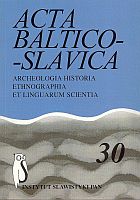Славизм kāpousti в названиях латышских блюд (этнолингвистичeский аспeкт)
Latvian Traditional Dishes (an ethnolinguistic aspect)
Author(s): Brigita BušmaneSubject(s): Language and Literature Studies
Published by: Instytut Slawistyki Polskiej Akademii Nauk
Keywords: dialectology; lexicology; semantics; traditional dishes; popular believes
Summary/Abstract: Cabbage belongs to the most ancient and widespread vegetables in the popular nourishment. In Latvia, they started to plant head-cabbage in the 11th century A. D. Data of Latvian folk-songs and popular believes as well as the use of the word kāpuosti among names of a traditional dish prepared on the occasion of swine slaughtering (e.g., a(p)bē¦du kāpuosti, cūku kāpuosti, verbatim “swine cabbage,” sietalkāpuosti, verbatim “fattened pig’s cabbage”) are testifying the significance of cabbage in popular nourishment since old times. The Standard Latvian word kāpuosts was borrowed from Old Russian капуста simultaneously with the appearance of this plant before the 13th century. In Standard Latvian, but more frequently in regional sub-dialects, names for various cabbage dishes are formed using the word kāpuosti (in the plural). They are mainly composite names with this word as the independent component, established due to a metonymical meaning transfer ‘product’ → ‘dish’. The depending component of composite names for dishes performs the differentiating function while comprising several information about this product (its features, preparing, etc.). Under semantic aspect, they have to be classified in 4 main groups: 1) names that contain in their 1st part a noun differentiating the dish upon the product (e. g., mugurkaula kāpuosti, verbatim “backbone cabbage,” lapu kāpuosti, verbatim “leaf cabbage,” galviņu kāpuosti, verbatim “head cabbage”), 2) names with reference to a feature or property of the dish in their 1st part (e. g., salde¦nie kāpuosti – cf. salde¦ns ‘sweet’, šķīstie kāpuosti – cf. šķīsts ‘watery’, baltie kāpuosti – cf. balts ‘white’), 3) names whose 1st component includes reference to an action performed when preparing the dish (e.g., sutinātie kāpuosti, štuovē¦tie kāpuosti – cf. sutināt, štuovēt ‘to stew’), 4) names containing reference to the preparing period, or intention, of the dish (a(p)bē¦du kāpuosti – cf. a(p)bē¦das ‘swine slaughtering’, šķirību kāpuosti – cf. šķirt ‘to divide’, šķirties ‘to separate’). In Latvian regional sub-dialects the word kāpuosti also denotes a dish made of other vegetables (e.g., biešu kāpuosti, verbatim “beet cabbage,” balandu kāpuosti, verbatim “garden orach’s cabbage,” skābiņu kāpusti, verbatim “sorrel cabbage”). Semantic and word formational equivalents in Latvian and Slavic material are testifying the antiquity of the borrowed word kāpuosti in Latvian, as well as giving evidence of common linguistic phenomena in these languages.
Journal: Acta Baltico Slavica
- Issue Year: 2006
- Issue No: 30
- Page Range: 233-240
- Page Count: 8
- Language: Russian

